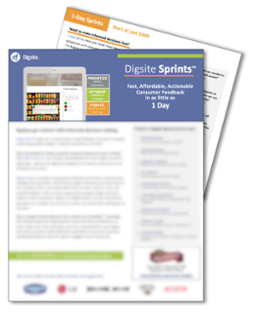Loyalty programs are designed to increase customer engagement and drive more sales. But what do consumers really want in a loyalty program? And, how can you increase the chances your loyalty program will be successful? We talked to over 100 consumers using our Digsite Sprint platform to find out.
Key Findings:
-
Loyalty programs make customers feel better about spending their money
-
Frequency of getting rewards is a key part of consumers expectation of participating in a loyalty program. For places they visit more often, points work well. For places they visit less often, instant coupons or other rewards are needed to “love it”
-
Customers want loyalty programs to be flexible. Adding smaller perks/rewards or more flexibility in using rewards may make your loyalty program a favorite.
-
Customers care most about simplicity, honesty and transparency in the loyalty programs they join.
There’s a reason so many leading brands have developed loyalty programs: Successful ones can unlock enormous revenue streams. In fact, though loyal customers may only account for 12%–15% of a company’s customers, that small chunk of shoppers can be responsible for up to 70% of all sales. See below for some loyalty programs we evaluated in this research and customers’ views towards them:
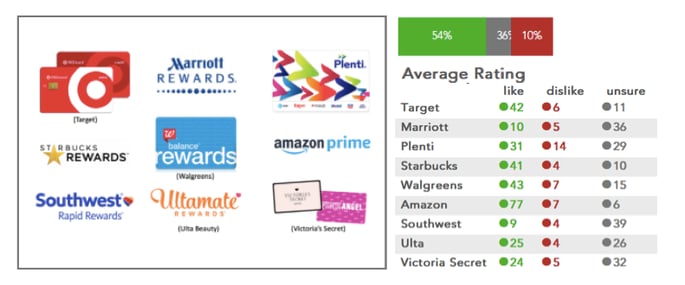
As you can see, Starbucks was one of the most liked loyalty programs. This isn't surprising, as the coffee juggernaut’s loyalty program, Starbucks Rewards, has more assets than many banks. Twelve million Starbucks customers have collectively preloaded $1.2 billion onto their Starbucks cards due to the incentives they receive in return.
If you’re going to drink coffee every day, you might as well try to save a little bit of cash, right?
Unfortunately, companies can’t simply patch together a loyalty program and expect it to work exactly as Starbucks’ has. Building a successful loyalty program takes time and effort. Once they’re implemented, it can be quite a while before programs really take off.
For example, Starbucks’ loyalty program was launched in 2009. That $1.2 billion didn’t materialize overnight.
So do loyalty programs work? As Starbucks has demonstrated, absolutely. They just need to be designed well.
How exactly can a company build a program that will help it achieve the goals it has in mind? It’s actually pretty simple. Businesses that wish to launch loyalty programs need to use data to continually refine said programs after they’ve been rolled out.
OK, great. But where does that data come from?
We may be a bit biased here, but we believe Digsite Sprints℠ is the best tool companies can use to generate the consumer insights they need to fine-tune their loyalty programs. This online market research tool allowed us to gather in-depth consumer insights on loyalty programs in just 24 hours. To learn about how to buy online qualitative research, check out our whitepaper!
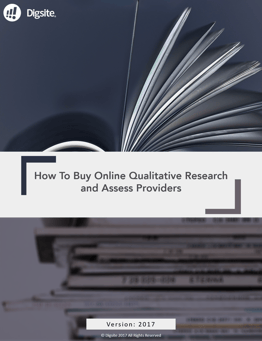
Here are some of our major takeaways:
Insight #1: Loyalty programs make customers feel better about spending their money
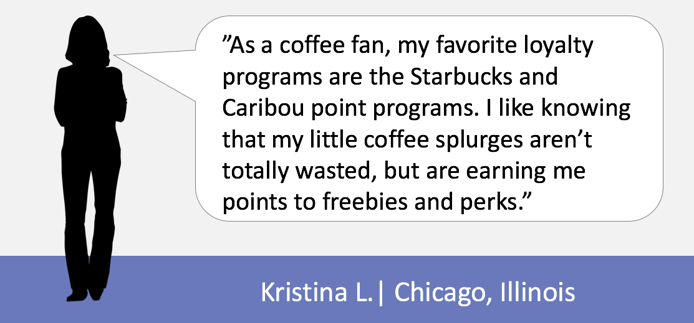
If you’re going to be spending money to buy things in the first place, you might as well stretch your money out as far as you possibly can.
That’s a sentiment many shoppers share when it comes to loyalty programs.
“One of my favorite loyalty programs is Petco,” explains Kari F. “A lot of my free time goes to my puppies, so anything dog-related, I’m on it! Petco Pals rewards program works like this: If you spend $100, you get $5 back—plus extra coupons emailed to you.”
With an army of new puppies under her watch, Kari obviously needs to spend a ton of money on food and supplies. Who wouldn’t want to get 5% off those expenditures if they could?
Anytime a consumer can get money back from a business they support regularly, there’s a good chance they will pursue the opportunity.
Refer back to the loyalty stat at the beginning of this report and you’ll quickly see why your company—regardless of what industry it’s in and who your target customers are—should do whatever needs to be done in order to establish a loyalty program.
Insight #2: Frequency is a major component of successful loyalty programs
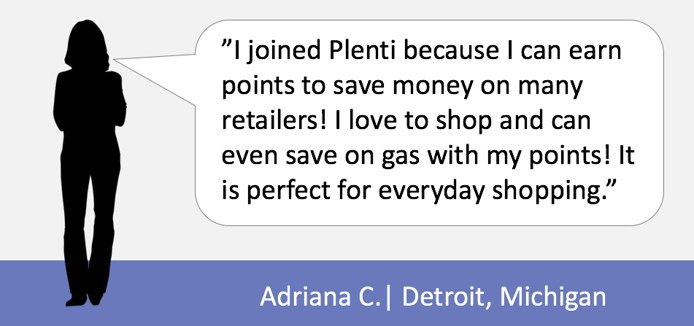
Our research also revealed that loyalty programs that offer consumers rewards often fare better than those that make rewards harder for shoppers to obtain.
Everybody goes to the supermarket several times a month—if not more frequently. According to one report, it can cost roughly $300 to feed a family of four each week. That’s a lot of money no matter how you slice it.
Since the average consumer spends a lot of money at supermarkets and everyone needs to eat, it comes as no surprise that supermarket loyalty programs that give customers discounts and deals are quite popular.
“My favorite loyalty program is Kroger supermarket where I can use my Kroger loyalty card to earn fuel points when I shop for items there,” explains Lynn G. “I save money on gas which helps a lot. I also love the digital coupons I can upload to my card and often get free or almost-free items with them. I love saving money and Kroger helps me do it often.”
In order for your loyalty program to deliver the results you hope for, make sure that customers are rewarded frequently. If they are given points every time they make a purchase, for example, that positive reinforcement can go a long way toward encouraging them to reach deeper into their wallets—and more often. For places consumers visit less often, instant coupons or other types of rewards may be needed to keep them interested.
Insight #3: Customers want loyalty programs to be flexible
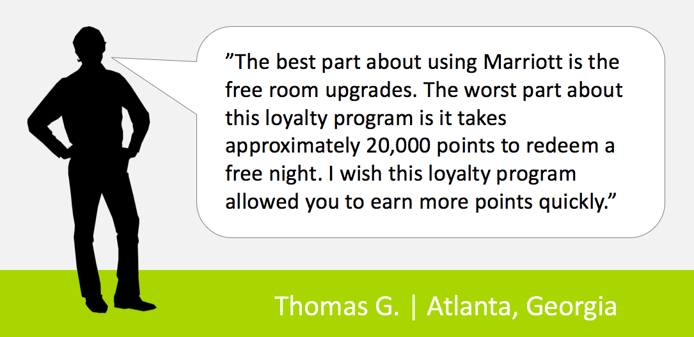
The more restrictions you have on your loyalty program, the less satisfied your customers will be with it. On the flipside, if you build a loyalty program that enables participants to use their rewards how they want to when they want to - you’ll enjoy success.
While Starbucks’ loyalty program can be a case study in how to do it the right way, there’s still room for improvement.
In our Digsite Sprint, we found that participants in the program felt that the fact Starbucks rewards expire was unfortunate, for example.
“The best part about using Starbucks Rewards is free drinks,” explains Katy S. “The worst part about this loyalty program is points expire. I wish this loyalty program would not allow points to expire.”
Successful loyalty programs enable customers to earn points quickly—and redeem them soon after they’re accumulated. The more ways customers can redeem points, the better. For example, major credit card companies allow customers to get their rewards either as cash back or use them to get discounts on a variety of items.
The more flexible and customer-centric your rewards program is, the more likely you’ll be to enjoy success.
Insight #4: Loyalty programs encourage customers to try new brands
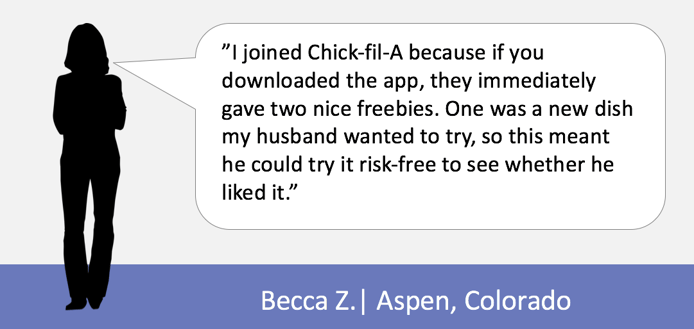
You can’t dispute the fact that people like loyalty programs—to the point where they are willing to support brands and businesses simply to reap the benefits of being a loyal customer.
For example, when a new Domino’s restaurant opened near one Digsite Sprint participant, she decided to give it a try—in part because of the pizza chain’s loyalty program.
“A new store opened up close to my home so we had to try them out,” says Kacie R. “I saw they had a program to earn free pizza so I had to join.”
While loyalty programs encourage customers to try new brands—particularly when freebies are offered—they also encourage them to continue supporting those brands in order to maximize their rewards.
Insight #5: Customers expect loyalty programs to be easy to use
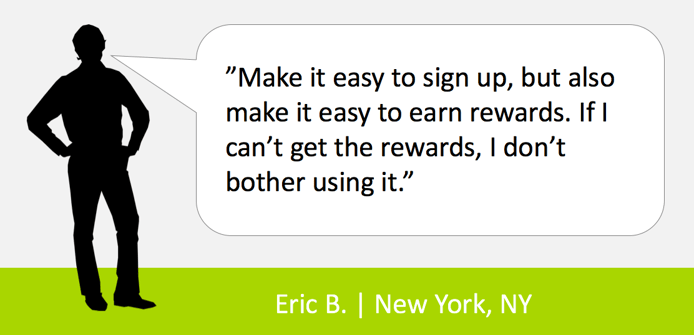
You can’t expect to be able to force your customers to hop through hoop after hoop to enjoy the perks associated with your rewards program. For loyalty programs to succeed, you need to make it as easy as possible for customers to use them.
To illustrate: A few years ago, American Express rolled out Plenti, its reward program. Plenti has been hailed as one of the more innovative loyalty programs of late. Instead of having to keep track of a number of rewards programs, Plenti aims to be the go-to rewards program that many major companies use. For example, customers can get Plenti points at both Walgreens and Chili’s.
It’s easy to see why Plenti could be considered “innovative”—who wants to carry around several rewards cards when you only have to carry around one? However, Digsite Sprint participants had mixed reviews about the program. For the most part, everyone agreed that getting money back was great. But some participants found Plenti to be quite confusing.
“The worst part about this loyalty program is the points system,” says Tene S. “I wish this loyalty program had a better explanation for their points system.”
Others echoed her sentiments.
“I think I’ve signed up for Plenti—maybe even more than once,” explains Laura S. “But I’ve never really understood the program and I guess I don’t shop at enough Plenti-affiliated stores for it to really matter.”
Here’s a look at which aspects of loyalty programs are most attractive to customers:
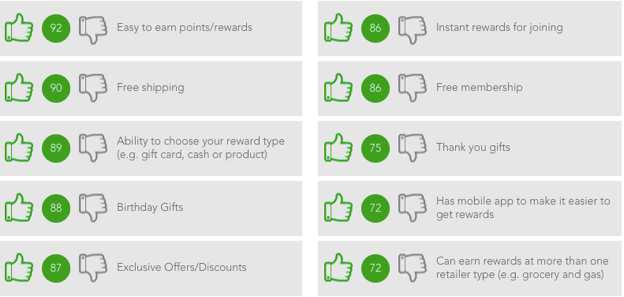
According to our research, customers care most about simplicity, honesty and transparency in the loyalty programs they join. Don’t make your customers jump through hoops only to get less-than-desirable rewards. Make it worth their while—and they’ll make it worth yours.
To learn more about how you can use Digsite Sprints to collect the data you need to build a rewards program that delivers results, download our Digsite Sprints Fact Sheet!
